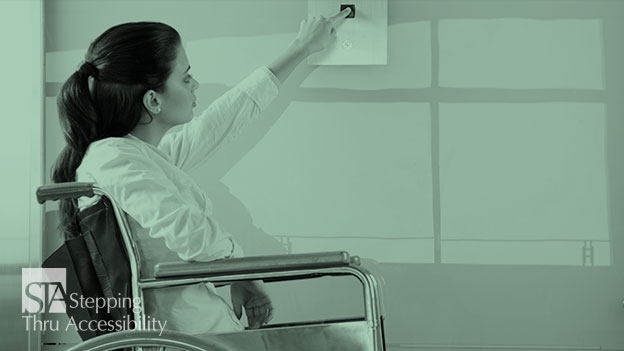Blog
Return to Blog »
Janis Kent, Architect, FAIA, CASp © December, 2015 There are certain things in Access that at first and even second glance, appear to be clear. But many of the simple things are not as intuitive as you might imagine, particularly if you are not a wheelchair user. Clear floor spaces, for instance. We know that a clear floor space is 30” x 48” unless confined on all or part of three sides. But how do we apply it, how do we show it – particularly when we have enough space so the long edge can be either parallel or perpendicular to an element? That is the question. When we talk about clear floor spaces, think of the approach to an element, whether forward or parallel, and in some circumstances both. But, it is not just providing a space, or drawing a rectangle perpendicular or parallel to an element. In most cases, clear floor spaces relate directly to reach ranges. So one of the questions is, what do I need to reach? If it is something on a vertical surface, then either a front or side approach is feasible. The rectangular space can then be placed either parallel or at right angles to this vertical surface depending upon the space you have. Forward or Front Approach But remember, for forward approach, where the long edge is perpendicular to the object or vertical surface, we can only reach as far as our toes. This is fine for a control or switch located on a wall or other vertical surface, but would not provide access for a recessed object. This is also true for forward reach over an object with knee/toe clearance below – again we are limited to the clear maximum distance of our toes below which may be suitable for some tasks and is actually preferable for others since the user does not need to twist their body. Parallel or Side Approach Side approach, where the long edge is parallel to the object or vertical surface, does have more flexibility. You can reach the vertical surface but you can also reach up to 24″ further (dependent upon obstruction height), whether recessed or over an object. If we need to reach beyond the vertical surface, then we are limited to side approach only. Some examples; Clear Floor Space Sizes Clear floor spaces are typically 30″ x 48″ minimum unless blocked on all or part of three sides for more than half the distance. If blocked by objects or within an alcove, then the clear floor space increases from 30″ x 48″ to either 36″ x 48″ or 60″ x 30″. If it is the 48″ side which is blocked for more than half for front approach, then the width increases to 36″. For parallel approach, if it is the 30″ side which is blocked for more than half, then the length increases from 48″ to 60″. If the clear floor space is even partially blocked on a side, one full edge of the clear floor space is required to adjoin an accessible route or another clear floor space. Related Article: Path of Travel Considerations – for the Deaf Community & Others Summary In summary, when you are locating and placing a clear floor space, you will need to think of how the element is being used. Keep in mind, that the minimum space for a wheelchair of 30” x 48” covers about 80%-85% of manual wheelchairs. This means that this is not enough space for about 15% to 20% of manual wheelchairs and even less for powered chairs and scooters. The 30” x 48” space actually is enough for approximately half of all types of wheeled mobility devices. Clear floor spaces tie into reach ranges with parallel approach having more flexibility than front approach unless there is knee/toe clearance under an object. With parallel approach, about 85% of manual wheelchair users have a side reach of 16”, increasing to about 95% with a side reach of only 12”. With a forward approach, do remember that you can not reach further than your toes, but only about 77% of manual wheelchair users can even reach this far. And with both forward and side reaches the distance decreases further if holding a weight. So clear floor spaces do take a bit of thought of how they tie into reach ranges for access. Be aware that your local City or County may have additional requirements that are more restrictive and providing greater access than the State or Federal requirements. Also, this article is an interpretation and opinion of the writer. It is meant as a summary – current original regulations should always be reviewed when making any decisions. © Janis Kent, Architect, FAIA, CASp 2015Clear Floor Spaces – Are they Really Clear?
